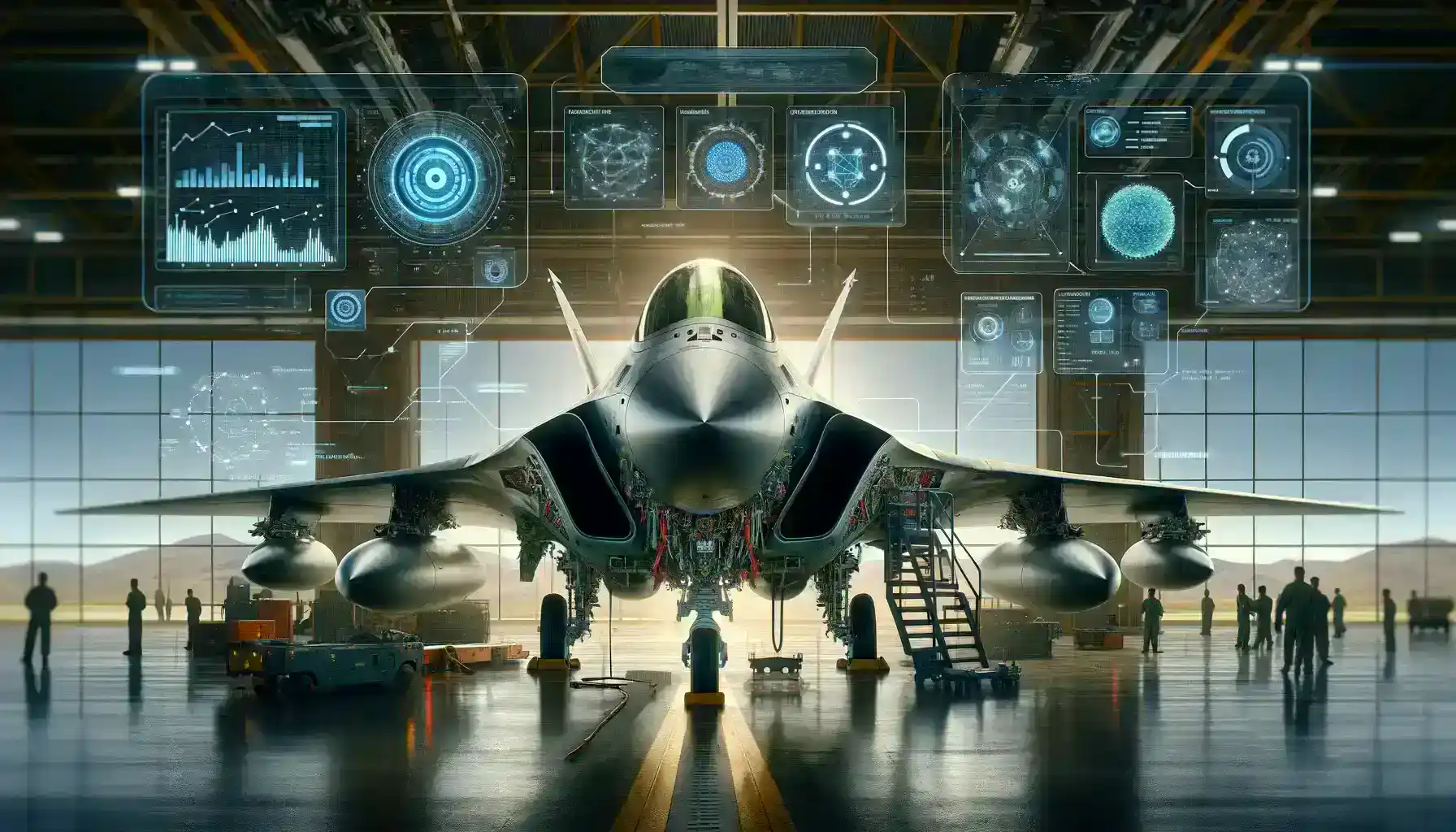Table of Contents
In an era marked by rapid technological advancements, the synergy between artificial intelligence (AI) and military aviation has emerged as a pivotal force, reshaping the trajectory of Air Force operations. This article, titled “Elevating Airforce Excellence: The Future Flight with AI Wings and Cutting-Edge Tools,” embarks on a journey to unravel the transformative impact of AI on the realm of flight, with a specific focus on AI-enhanced Airforce capabilities.
As nations worldwide seek to bolster their defense strategies, the integration of AI technologies into Air Force operations stands out as a beacon of innovation. The term “AI-enhanced Airforce” encapsulates a paradigm shift, where intelligent algorithms and cutting-edge tools collaborate to optimize aircraft performance, enhance mission planning, and fortify overall operational efficiency.
This article delves into the multifaceted dimensions of this technological evolution. From the revolutionary design of AI-empowered wings to the deployment of sophisticated AI tools that navigate the complexities of modern warfare, the narrative unfolds the narrative of a future flight propelled by artificial intelligence. As we explore real-world samples and cutting-edge AI applications, the stage is set to showcase how these advancements are not only elevating Air Force excellence today but also charting an ambitious course for the future of military aviation.

The Rise of AI-Enhanced Airforce Operations: Understanding the Foundation
Military aviation is undergoing a profound transformation, propelled by the integration of artificial intelligence (AI). To truly appreciate the significance of AI-enhanced Air Force operations, it’s crucial to delve into the foundational changes taking place within the realm of military aviation. AI, fueled by advanced algorithms and machine learning, is emerging as a force multiplier, ushering in a new era that enhances the capabilities of both airforce personnel and machinery.
Understanding the Foundation
At its core, AI-enhanced Air Force operations represent a paradigm shift in the way military aviation functions. Traditional approaches are being augmented and, in some cases, replaced by intelligent systems capable of processing vast amounts of data in real time. The foundational changes encompass not only technological advancements but also a strategic shift in how airforce missions are conceived and executed.
AI, driven by sophisticated algorithms and machine learning capabilities, has the potential to analyze complex scenarios, predict outcomes, and adapt to dynamic environments. This adaptability is a key attribute that positions AI as a game-changer in military aviation.
The Skyborg Project:
An ideal illustration of the transformative power of AI in airforce operations is the United States Air Force’s Skyborg project. Skyborg represents a cutting-edge initiative that aims to develop an AI-driven autonomous drone designed to operate seamlessly alongside piloted aircraft. This project is emblematic of the Air Force’s commitment to exploring the full spectrum of AI capabilities.
The primary goal of the Skyborg project is to create an autonomous system capable of making decisions in real-time, responding to evolving situations, and complementing the skills of human pilots. Unlike conventional drones that are remotely operated, the AI-driven autonomous drone envisioned by Skyborg possesses a level of intelligence that allows it to operate independently while collaborating with human pilots.
The Role of AI Tools in Precision Aviation: Crafting Smart Defense Strategies
In modern airforce operations, the integration of AI tools has become instrumental in shaping smart defense strategies. These tools, driven by advanced algorithms and machine learning capabilities, contribute significantly to enhancing situational awareness and response times, ultimately ensuring a more robust and efficient aviation.
Enhancing Situational Awareness
AI tools leverage data analytics to process vast amounts of information in real-time. This includes data from various sources such as radar systems, satellite imagery, and communication networks. By rapidly analyzing and interpreting this data, AI enhances situational awareness for Air Force personnel. This capability is crucial in identifying potential threats, monitoring airspace activities, and responding promptly to changing scenarios.
Predictive Modeling for Mission Success
Predictive modeling, another facet of AI tools, enables Air Force strategists to simulate and analyze different scenarios. By inputting various parameters such as weather conditions, enemy movements, and aircraft capabilities, predictive models can forecast potential outcomes. This aids in mission planning, allowing airforce commanders to make informed decisions and optimize their strategies for mission success.
Predictive Maintenance with AI
One concrete benchmark of AI’s contribution to smart defense strategies is the implementation of predictive maintenance in airforce fleets. This application not only showcases the capabilities of AI but also emphasizes the importance of maintaining aircraft in peak condition for operational efficiency.
Predictive maintenance involves
Data Analysis: AI tools analyze data from sensors embedded in aircraft, monitoring various parameters such as engine performance, structural integrity, and system functionality.
Historical Maintenance Records: By cross-referencing real-time data with historical maintenance records, AI establishes patterns and identifies components that are prone to failure based on usage, environmental conditions, and previous issues.
Predictive Algorithms: Using predictive algorithms, AI tools can forecast when specific components are likely to fail in the future. These algorithms become more accurate over time as they continuously learn from new data inputs.
Benefits of Predictive Maintenance in AI-Enhanced Airforce
Proactive Maintenance: Predictive maintenance allows for proactive intervention before critical components fail. This proactive approach minimizes the risk of unexpected breakdowns during crucial missions.
Optimal Aircraft Condition: By addressing potential issues before they escalate, AI-enhanced AirForce predictive maintenance ensures that airforce aircraft are consistently in optimal condition, maximizing their operational effectiveness.
Downtime Reduction: Anticipating maintenance needs in advance reduces unplanned downtime, enabling airforce fleets to maintain high levels of availability for mission deployment.
Cost Savings: The proactive nature of predictive maintenance not only prevents costly repairs but also contributes to overall cost savings by extending the lifespan of aircraft components.

Navigating the Skies with Intelligent Wings: Advancements in Aircraft Autonomy
In the ever-evolving landscape of military aviation, the infusion of artificial intelligence has ushered in a paradigm shift, extending far beyond the confines of traditional fighter jets. The emergence of autonomous drones, equipped with sophisticated AI algorithms, marks a transformative leap in the capabilities of airforce operations, particularly in the realms of surveillance, reconnaissance, and combat scenarios.
Advancements in Aircraft Autonomy
The concept of aircraft autonomy, empowered by AI, redefines the traditional roles of airforce assets. Autonomous drones, often referred to as “intelligent wings,” are designed to operate independently, guided by AI algorithms that enable them to navigate the complexities of the skies with unprecedented efficiency.
The MQ-9 Reaper
A prime illustration of this transformative integration is found in the MQ-9 Reaper, a formidable hunter-killer drone that epitomizes the practical application of intelligent wings. Unlike conventional aircraft, the MQ-9 Reaper boasts AI-driven capabilities that elevate its operational prowess to new heights.
This drone is not merely a remotely piloted vehicle; it is a sophisticated AI-powered platform capable of autonomously patrolling vast areas, identifying potential targets, and executing precision strikes with remarkable accuracy. The integration of AI-enhanced airforce the Reaper to adapt to dynamic environments, assess threats in real-time, and make split-second decisions, showcasing a level of autonomy that was once confined to the realm of science fiction.
Highlighting AI-Enhanced Airforce Efficiency and Reach:
The MQ-9 Reaper’s capabilities underscore how AI-enhanced airforce operations are revolutionizing mission efficiency and expanding the reach of military initiatives. By autonomously navigating expansive territories, the Reaper can cover ground that would be impractical or risky for human-operated aircraft. This not only enhances the scope of surveillance and reconnaissance but also positions the Air Force for more effective responses in combat situations.
Unlocking Next-Gen Excellence in Military Aviation: Human-AI Collaboration
In the evolution of military aviation, a pivotal advancement defining next-gen excellence lies in the seamless collaboration between human expertise and AI capabilities. This synergistic relationship positions AI as a valuable co-pilot, contributing significantly to data processing, analysis, and decision support within AI-enhanced airforce operations.
Human-AI Synergy
The integration of AI into airforce operations acknowledges the unique strengths of both machines and humans. While humans bring intuition, adaptability, and contextual understanding to the table, AI excels at processing vast datasets, identifying patterns, and providing rapid insights. Together, they form a symbiotic partnership that leverages the strengths of each to achieve a level of excellence unattainable by either alone.
AI as a Co-Pilot
In the context of military aviation, AI functions as a co-pilot, augmenting human pilots with enhanced capabilities. This partnership enables airforce personnel to navigate the complexities of modern warfare with greater precision, efficiency, and situational awareness. AI processes real-time data from a multitude of sources, presenting actionable information to human pilots, thereby allowing them to make more informed decisions in dynamic and high-pressure scenarios.
Project Maven: An illustrative instance of this Human-AI collaboration is Project Maven, an initiative spearheaded by the U.S. Department of Defense. This project specifically focuses on integrating AI into military intelligence, harnessing machine learning algorithms to analyze extensive datasets, including imagery. The primary goal of Project Maven is to enhance the accuracy and speed of decision-making by providing valuable insights derived from the analysis of large and complex information sets.
By utilizing AI in military intelligence, Project Maven showcases the potential for AI to assist airforce personnel in navigating complex scenarios. The machine’s ability to rapidly process and analyze data allows human operators to focus on strategic thinking and decision implementation, thereby elevating the overall efficiency and effectiveness of airforce operations.

Conclusion: Toward a Future of Intelligent Airforce Operations
As we reflect on the flight of the future, it’s evident that AI-enhanced airforce operations are not just a vision but a tangible reality. Real-world instances such as the Skyborg project, predictive maintenance, the MQ-9 Reaper, and Project Maven illustrate the transformative impact of AI on military aviation.
As AI tools continue to evolve, their integration into AI-enhanced airforce operations will likely become more sophisticated. The path forward involves addressing challenges, ensuring ethical considerations, and embracing innovation that enhances both efficiency and precision in the skies.
In conclusion, the journey toward intelligent airforce excellence is ongoing, with AI wings propelling us beyond the horizon into a future where collaboration between humans and AI defines the new standard for military aviation.